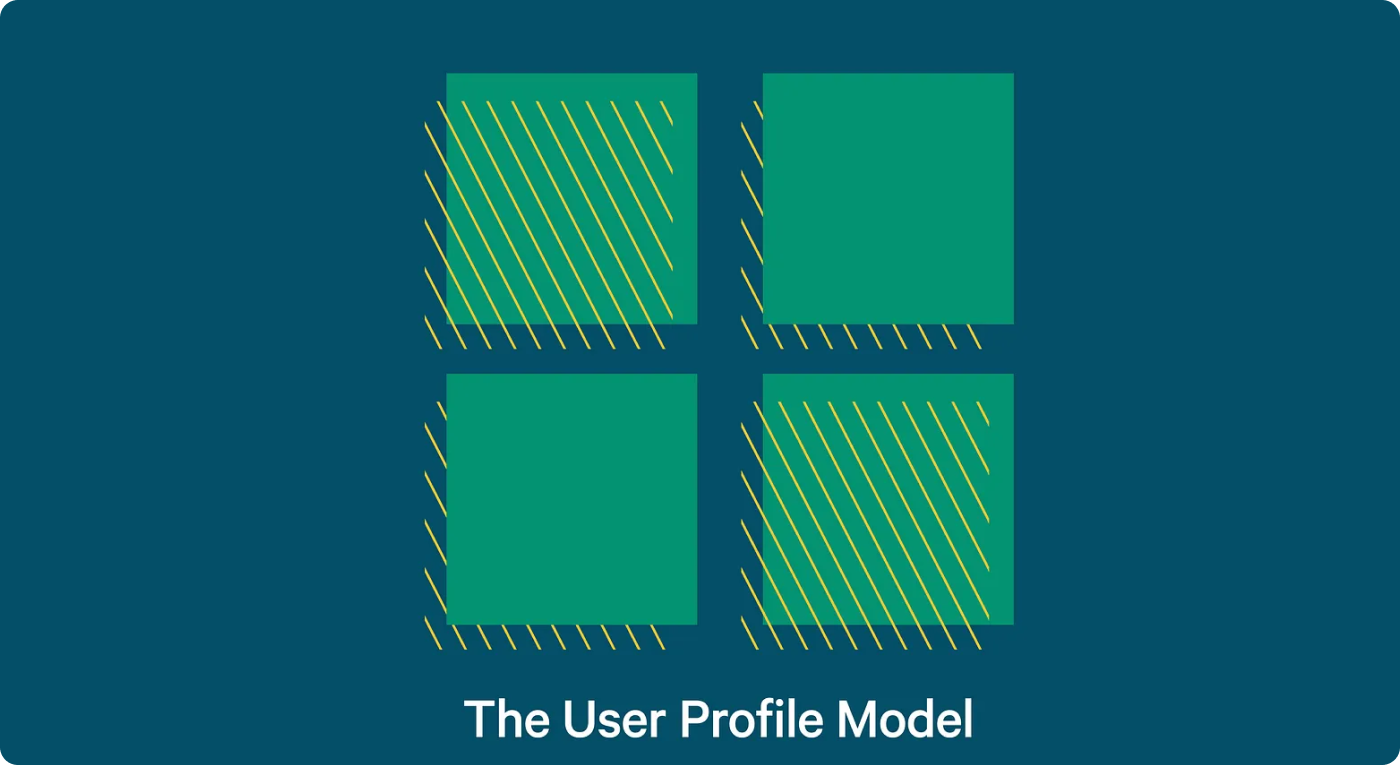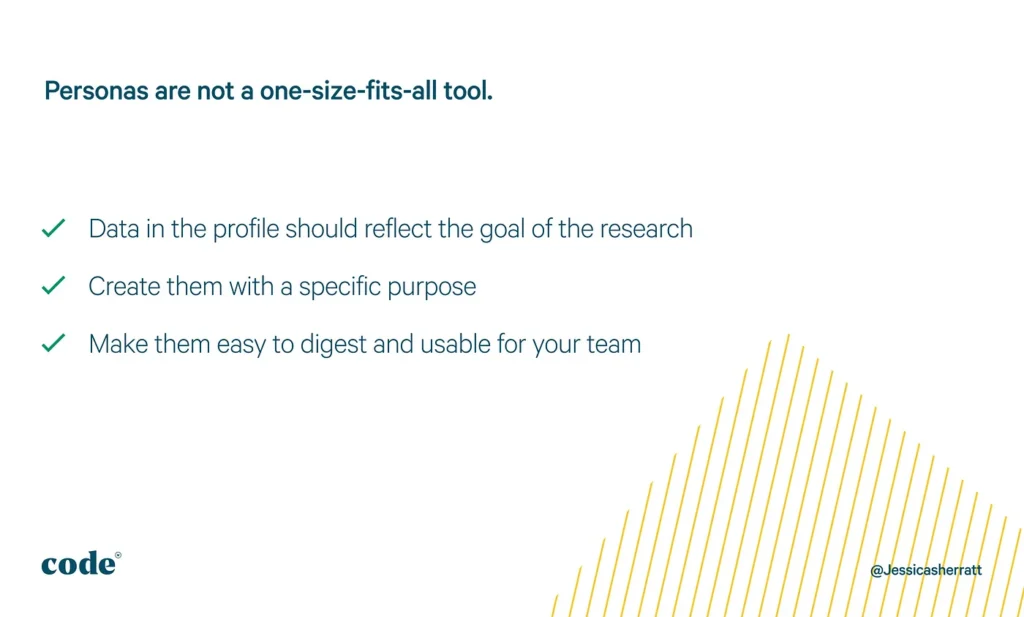Over the last decade, UX has come to the fore and people are now at the heart of everything we create, do, and achieve. We hire people to be user advocates, conduct research about their situations and demonstrate empathy for them.
It has been great to witness the change in businesses seeking research. They have become eager to know what the customer thinks about their product, which in turn has developed into what the user needs.
“64% of companies with a customer-focused CEO believe they are more profitable than their competitors”
— 19th Annual Global CEO Survey / January 2016
However, it is precisely because of these human-centered initiatives, that sometimes, research becomes a checkbox and gets left on the shelf. Some businesses still believe that because they have listened to their consumers, they are being customer-centric. Yet, that doesn’t necessarily mean that the research is having an impact on the decisions being made.
The problem: Personas are not a one-size-fits-all tool
When conducting research, we set out to achieve a specific objective and create outputs that communicate what we found for this.
For personas to be useful, the data captured in a persona should reflect the goal for that persona and the scope of work it is meant to impact.
Nielson Norman Group wrote the article Why Personas Fail
Why a persona may not be used:
- They do not match the needs of the teams using them
- They have been created in a silo, but then forced upon other teams
- Members of the team do not understand what they are or why they are useful
- Leadership teams do not understand the value or role of a persona
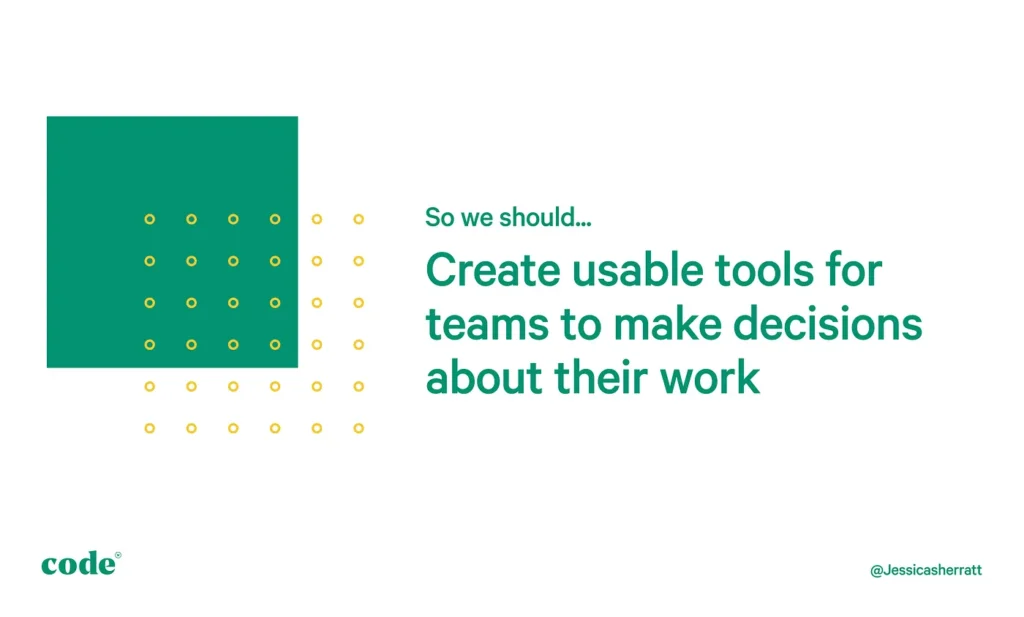
Over the thousands of hours I have spent facilitating, observing, and analyzing research, I have come across many problems in trying to communicate what I have found as part of the design process. All of these problems have led me to create this user profile model as a way of approaching user research. Each of these profiles has a purpose and scenarios where they are most useful and relevant. With UX research, I feel it is our responsibility to communicate our findings and create usable tools for teams to make decisions about their work.
Introducing the user profile model
This is a model I have developed to help teams identify what they are trying to do. It can also help your team to know what they can expect as an output from the research. It focuses on four key themes for the different challenges of product thinking.
- Finding users. As a part of product thinking, we have to consider who our users are, where they are, and what they currently do — so that we can create a strategy that allows us to find them appropriately.
- Is the activity task-based? This allows us to focus on what tasks a user is trying to achieve. We can also look at where they may come up against problems carrying out said task.
- Enabling users. When enabling our users to interact with a product or service, we need to consider why they are doing the things they are doing, what their goals and context are, as well as how they go about doing it.
- Empathy-based profiles. These help teams understand the context and stories of the users. In turn, this can help teams to walk in their users’ shoes.
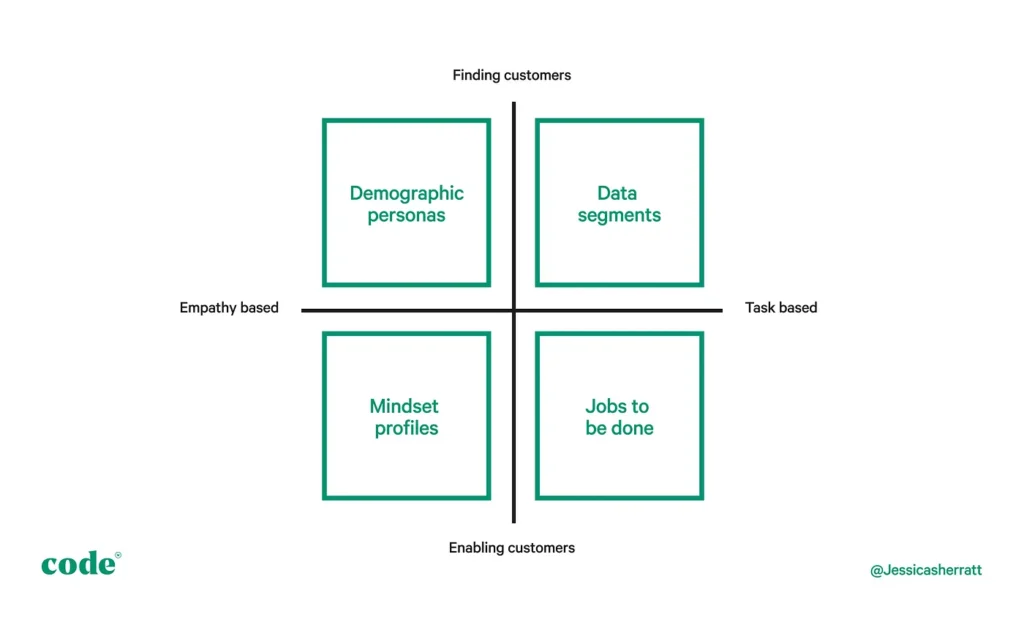
Types of profiles
First of all, let’s talk about the different types of profiles, their strengths and limitations, and then we’ll get down to how you can use them.
- Demographic personas are best used when finding users with highly targeted branded experiences, and are most likely to be used for marketing
- Data segments are best used when finding targeted user groups at scale, they are good for identifying who is currently using a product, and how to optimise things to their best ability
- Mindset profiles are best used when designing services with one core function for many different users, they help us to describe how people approach a problem and what they think influences their experience
- Jobs to be done are best used when designing a complex service for many different users, they help us identify what people are using the service for as well as what outcome they are looking to achieve
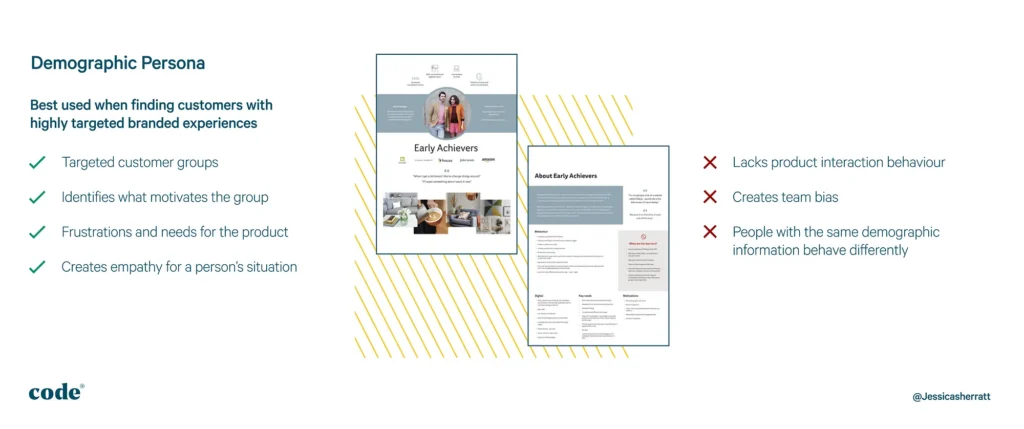
Demographic Persona
If we want to understand the context of people’s lives, so that we can target our marketing accordingly, then demographic personas are absolutely the right choice for this purpose. They can provide insight into how you might motivate and persuade the group into using the product. You can read more about them on usability.gov.
We conducted research for a national blinds company using mosaic shopper segments to understand how customers were behaving across a range of channels. We then paired this information with interviews of the users recruited from the matching segments from the data.
Using these data points we split the participants by age and income value. These were the factors that distinguished the different users based on their desirability around products and brands that could impact our marketing campaign.
This enabled the marketing team to understand the context of people’s lives so that we can understand how to best target, motivate and persuade them. It also shifted the minds of the marketing team, users stopped becoming a number of leads and were talked about more as ‘early adopters’ etc.
However, one thing to watch out for is bias and stereotypes being created. I have once been in a room where a group has been referred to as ‘tree hugging vegans’, which can lead to all sorts of wild assumptions.
This type of profile also did not help us understand how people go about using a product. It didn’t tell us what their interactions might be, nor did it account for people behaving differently within the same demographic. Indi Young once tweeted,“Please remove age, gender, ethnicity from your personas. None of these things cause behavior/ thinking but they do cause assumptions.”
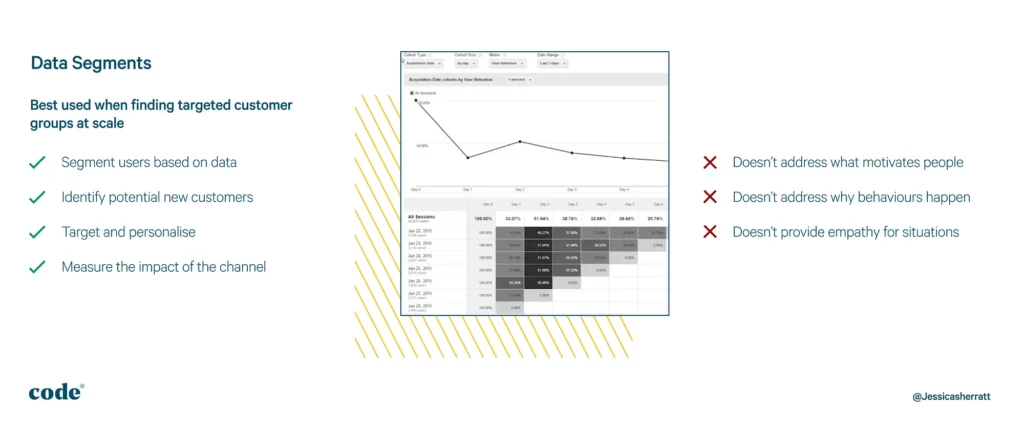
Data Segments
At Code, I define Data Segments as who and what we see people doing on a website. This data can be found using an analytics tool such as Google Analytics, where you can break the users down into Cohorts. Using this approach, you can understand how users are currently interacting with the product.
When working with a Commercial Property Development Group, we used data segments to identify the types of people currently using the website. We wanted to understand who people were, e.g. purchasers, decision makers or visitors etc, and their journeys on the website to know who we should be targeting.
By improving analytics, tracking and running a survey, we gained a better understanding of what people were coming onto the website for and whether they had been successful.
This allowed us to identify where we could start to experiment around key drop-offs to gain a deeper understanding of the experience. It also taught us the different groups we should interview, including those we had not previously considered. It was here where we got a deeper insight into these different segments and found the motivators for that audience.
Although useful for identifying people and behaviour, they did not help us understand what motivates these behaviours or why they happen. Due to it being data-based, these profiles provided facts but did not help to build empathy for the users’ situations.
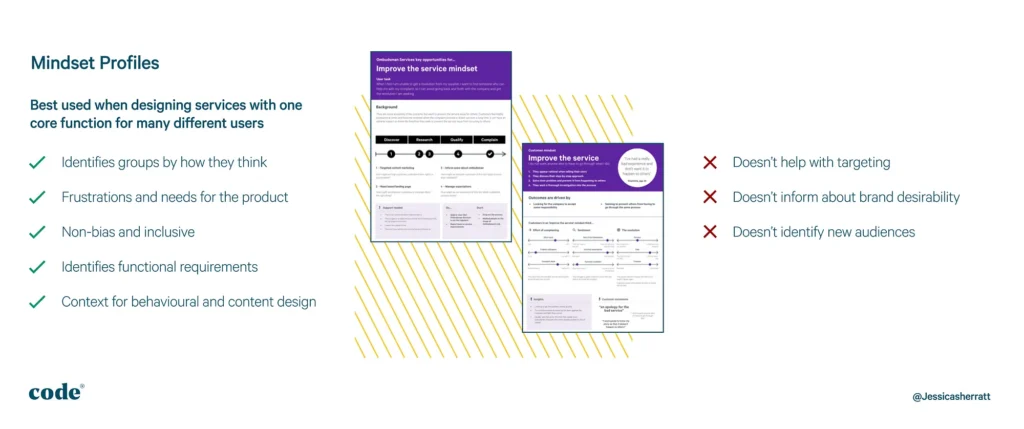
Mindset Profiles
Mindset profiles are something that a colleague and I developed while working on a product at Code. We used this to help our teams understand what outcome the users are trying to achieve, as well as help the users understand the current service and what it can do for them.
When working with an Ombudsman Service, we interviewed participants who had recently used the service to understand the experiences they had. When analysing the data, we found it difficult to segment participants by their demographics or the task they were trying to complete because their only task is to complain. Splitting the users in this way meant that a lot of the same information was relaid across each profile, which made them feel a little pointless. So we went back to the drawing board and started to regroup our participants based on their expectations of what the service would do for them before they started.
We found that this greatly impacted the decision factors and the measure of success participants had for their experience. These profiles allowed us to highlight how different groups perceive the service they are interacting with, what frustrations they have and the needs from the product or service. They were inclusive because they represented a 82 year old male and a 24 year old female who’s thinking were the same.
This enabled the team to consider their content design with the goal to help people change their perception, so that they would understand what the service can do for them throughout their journey.
However, these profiles didn’t help us understand how to target these kinds of users (especially since one person could be in all the identified mindsets at different times of their journey). Equally so, these mindsets did not help us identify new audiences. They are focused more on outcomes and so our understanding of what makes a brand desirable is left wanting.
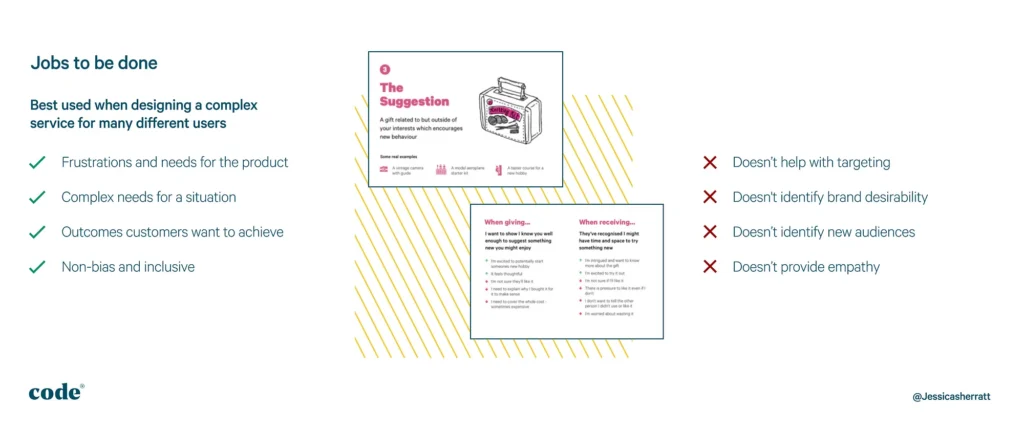
Jobs to be done
Jobs to be done is a framework well documented by Tony Ulwick which focuses on the ‘job’ or outcome a user is trying to achieve. To turn this into a user profile, we worked on a jobs-to-be-done profile around gifting, focusing on the forces diagram as part of that theory.
Code were asked, by a gift card company, to innovate around a new product in a new target market so that they could grow their business around gifting. To do this, we conducted research with their new target market and people outside of it. We conducted lots of different research methods and gathered lots of findings around both the gifting journey and receiving experience.
We soon realised that there were lots of nuances around gifting, especially when considering gifting and receiving. Each user was trying to achieve something slightly different, which impacted the frustrations and needs from the current services in the market. We learned that gifting was centred around the gesture and how it was perceived by the recipient.
Therefore we created jobs to be done gesture profiles. From this approach, we were able to help the teams to ideate how they might enable users to better gift or receive these gestures.
Jobs to be done has similarities with a mindset profile because the job focuses on the task rather than who the person is. However, these profiles did not help us to understand how to target these kinds of users, nor identify new audiences (in the gifting scenario, this had already been defined). They do not generally focus on what makes a brand desirable but more on the outcome. Finally, because they are not attributed to a person, they do not enable teams to gain empathy.
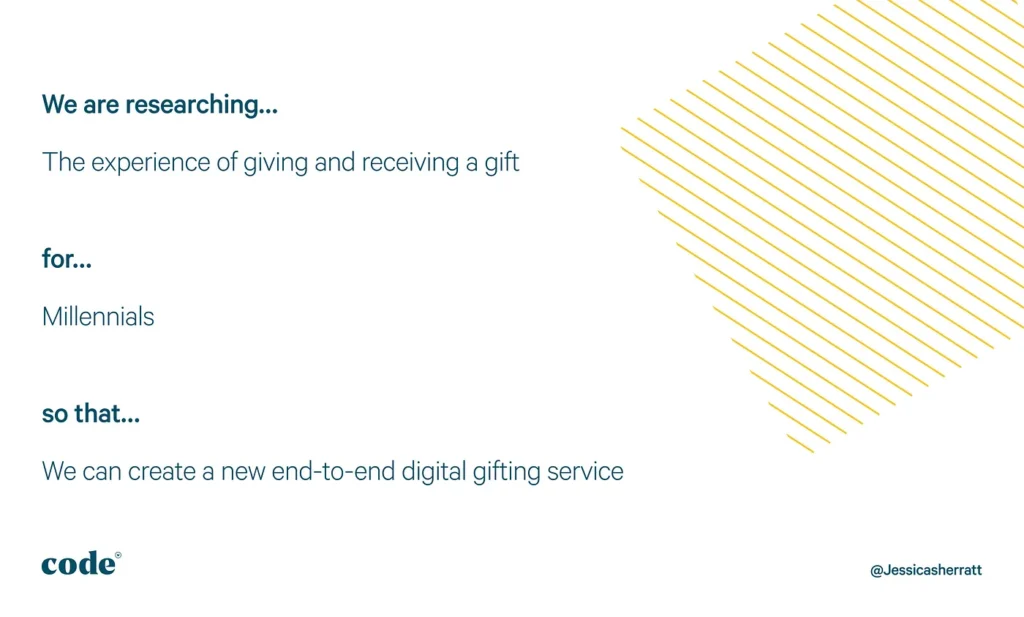
Start by setting yourself a research statement. There is nothing worse than trying to find out everything with no defined purpose and trying to shoehorn that into an output (speaking from personal experience, it is very frustrating when your research did not tell you what you needed).
So, start with why you want to do the research in the first place and use the rest to formulate your brief.
We are researching…[What do we want to understand? What experience do you want to focus on?]
For… [Who do we want to know about?]
so that… [What do we want to achieve? What is the outcome?]
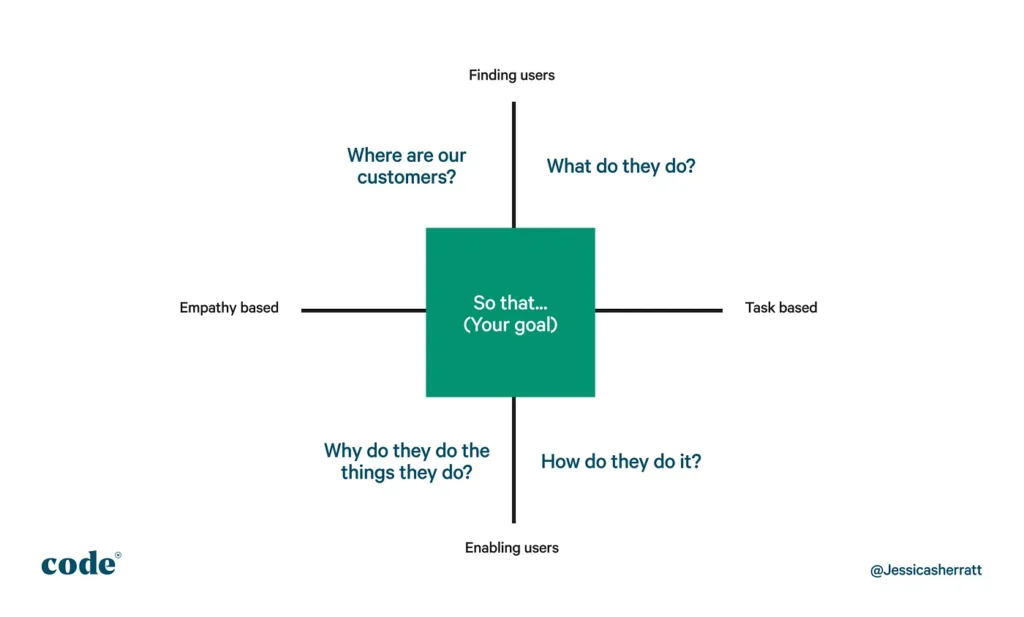
Once you have set your research goal, you can start to break down your research into smaller research questions.
Plot your research questions around these quadrants. It will help you identify the profile you are most likely to create and which research technique may be the best to use to achieve your research goal. When using these quadrants, it can also help you identify if you have a blind spot with your product or service.
When you have a blend of research questions
When you focus on your outcomes, it may become clear that one profile will not answer all of your questions. I have outlined two core ways that a blend of information could help depending on your task or stage in the design process.
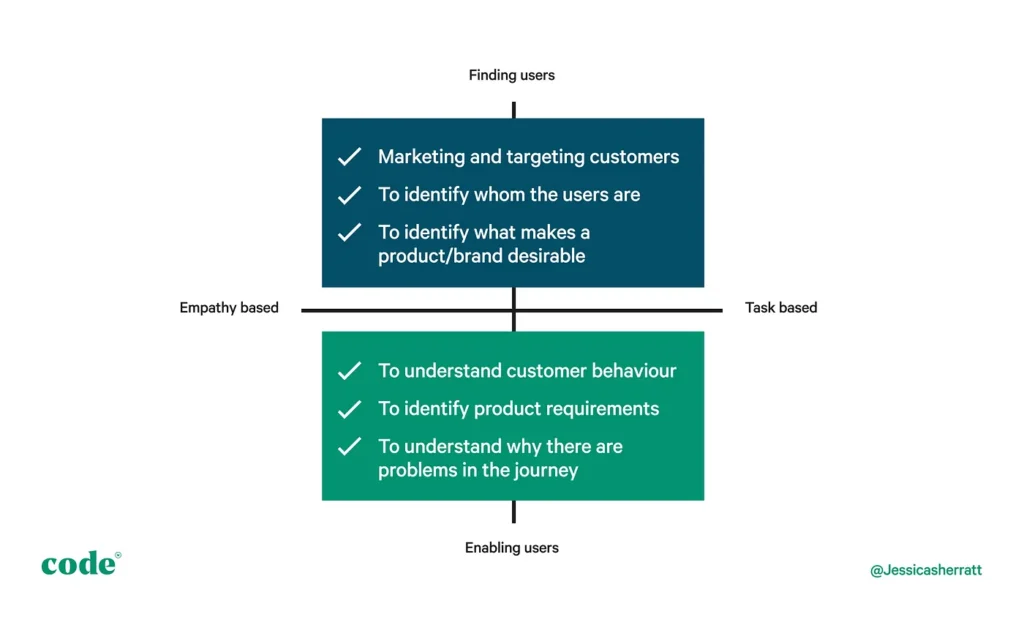
Acquiring users vs product experience
If you want to create a marketing campaign that draws in more of your high-converting users, a combination of the finder user profiles could be helpful here. For example, demographic personas and data segment information can work together to:
- Understand who you need to target
- Further your own understanding of your users
- Help you think about how to market to and target them
- Make you consider what makes your brand or product desirable
- Consider ways to personalize user journeys based on your campaign
- Improve your conversion funnel
If you want to improve your product’s usability, a combination of the finder user profiles could provide you with the information you need. For example, a mindset and jobs-to-be-done profile can help you:
- Understand the way users currently perceive your service
- Further your understanding of perception impact on behaviour
- Identify requirements
- Understand where problems occur and why
- Consider new ways to construct the user journey to complete a task
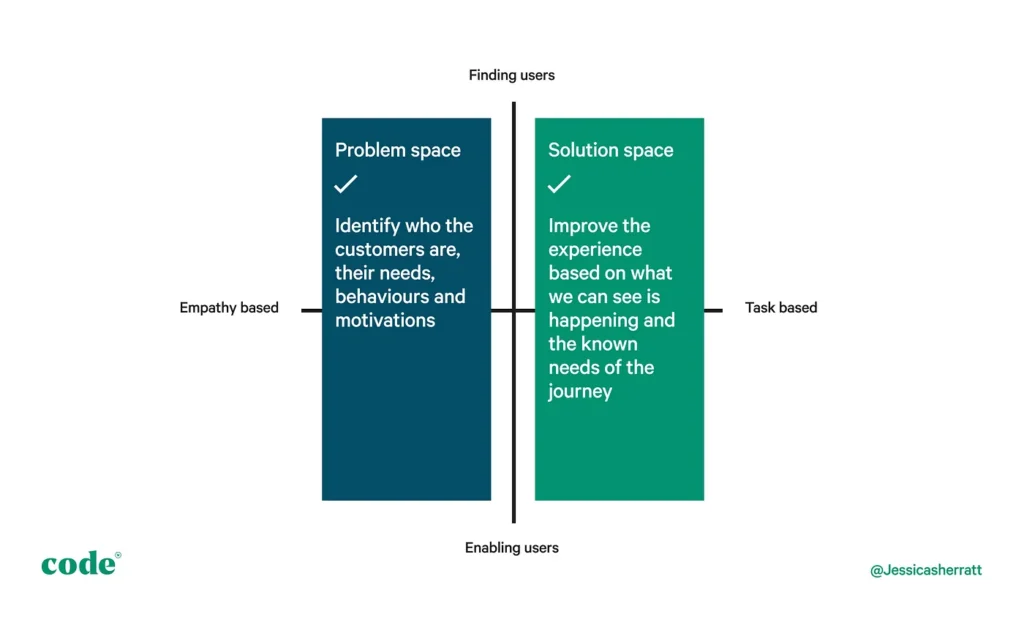
Problem space vs solution space
If you are in the problem space of your design process, you are probably most likely trying to understand your users and what makes them tick. In this instance, you may want to consider focusing on demographic personas and mindset profiles. The combination of this information will help you to identify who your users are, their needs, behaviours, and motivators.
If you are in the solution space of your design process, you may want to consider focusing on data segments and jobs to be done. Here, you will be able to improve the experience based on the behaviours you can currently see, and the known needs of the users and their tasks.
In summary
Different profiles have different roles to play in a product’s development. It may be cliche but start at the end. Understand why you are being asked to conduct some research. Work out what problem you are trying to solve. Set yourself a clear objective so that you can map your research questions to the quadrants. Define the role of the profile you are creating to get the biggest impact on your research and your team.
For personas to be useful, the data captured in a persona should reflect the goal for that persona and the scope of work it is meant to impact.
— Nielson Norman Group
Quick tips to create a profile:
- Data in the profile should reflect the goal of the research
- Create them with a specific purpose
- Make them easy to digest and usable for your team


